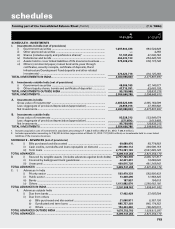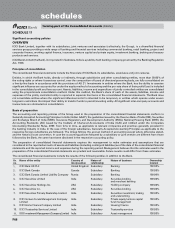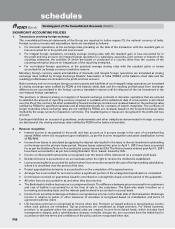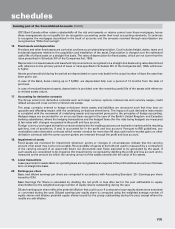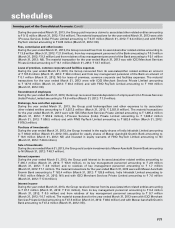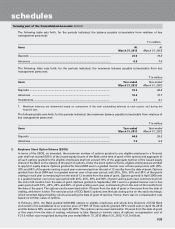ICICI Bank 2013 Annual Report Download - page 150
Download and view the complete annual report
Please find page 150 of the 2013 ICICI Bank annual report below. You can navigate through the pages in the report by either clicking on the pages listed below, or by using the keyword search tool below to find specific information within the annual report.
F72
All investments are classified into ‘Held to Maturity’, ‘Available for Sale’ and ‘Held for Trading’. Reclassifications, if
any, in any category are accounted for as per the RBI guidelines.
Under each classification, the investments are further categorised as (a) government securities, (b) other approved
securities, (c) shares, (d) bonds and debentures and (e) others
a) ‘Held to Maturity’ securities are carried at their acquisition cost or at amortised cost, if acquired at a premium
over the face value. Any premium over the face value of fixed rate and floating rate securities acquired is
amortised over the remaining period to maturity on a constant yield basis and straight line basis respectively.
b) ‘Available for Sale’ and ‘Held for Trading’ securities are valued periodically as per RBI guidelines. Any
premium over the face value of fixed rate and floating rate investments in government securities, classified
as ‘Available for Sale’, is amortised over the remaining period to maturity on constant yield basis and straight
line basis respectively. Quoted investments are valued based on the trades/quotes on the recognised stock
exchanges, subsidiary general ledger account transactions, price list of RBI or prices declared by Primary
Dealers Association of India jointly with Fixed Income Money Market and Derivatives Association (FIMMDA),
periodically.
The market/fair value of unquoted government securities which are in the nature of Statutory Liquidity Ratio
(SLR) securities included in the ‘Available for Sale’ and ‘Held for Trading’ categories is as per the rates published
by FIMMDA. The valuation of other unquoted fixed income securities wherever linked to the Yield-to-Maturity
(YTM) rates, is computed with a mark-up (reflecting associated credit risk) over the YTM rates for government
securities published by FIMMDA.
Unquoted equity shares are valued at the break-up value, if the latest balance sheet is available or at ` 1 as per
RBI guidelines.
Securities are valued scrip-wise and depreciation/appreciation is aggregated for each category. Net appreciation
in each category, if any, being unrealised, is ignored, while net depreciation is provided for. Non-performing
investments are identified based on the RBI guidelines.
c) Costs including brokerage and commission pertaining to investments, paid at the time of acquisition, are
charged to the profit and loss account. Cost of investments is computed based on the First-In-First-Out (FIFO)
method.
d) Profit/loss on sale of investments in the ‘Held to Maturity’ category is recognised in the profit and loss account
and profit is thereafter appropriated (net of applicable taxes and statutory reserve requirements) to Capital
Reserve. Profit/loss on sale of investments in ‘Available for sale’ and ‘Held for Trading’ categories is recognised
in the profit and loss account.
e)
Market repurchase and reverse repurchase transactions, are accounted for as borrowing and lending transactions
respectively in accordance with the extant RBI guidelines. The transactions with RBI under Liquidity Adjustment
Facility (LAF) are accounted for as borrowing and lending transactions.
f) Broken period interest (the amount of interest from the previous interest payment date till the date of purchase/
sale of instruments) on debt instruments is treated as a revenue item.
g) At the end of each reporting period, security receipts issued by asset reconstruction companies are valued
in accordance with the guidelines applicable to such instruments, prescribed by RBI from time to time.
Accordingly, in cases where the cash flows from security receipts issued by asset reconstruction companies
are limited to the actual realisation of the financial assets assigned to the instruments in the concerned scheme,
the Bank reckons the net asset value, obtained from the asset reconstruction company from time to time, for
valuation of such investments at each reporting period end.
h) The Bank follows trade date method of accounting for purchase and sale of investments, except for government
of India and state government securities where settlement date method of accounting is followed in accordance
with RBI guidelines.
ii) The Bank’s consolidating venture capital funds carry investments at fair values, with unrealised gains and temporary
losses on investments recognised as components of investors’ equity and accounted for in the unrealised
investment reserve account. The realised gains and losses on investments and units in mutual funds and unrealised
gains or losses on revaluation of units in mutual funds are accounted for in the profit and loss account. Provisions
are made in respect of accrued income considered doubtful. Such provisions as well as any subsequent recoveries
are recorded through the profit and loss account. Subscription to/purchase of investments are accounted at the
cost of acquisition inclusive of brokerage, commission and stamp duty. Bonus shares and right entitlements are
recorded when such benefits are known. Quoted investments are valued on the valuation date at the closing
market price. Quoted investments that are not traded on the valuation date but are traded during the two months
prior to the valuation date are valued at the latest known closing price. An appropriate discount is applied where
the asset management company considers it necessary to reflect restrictions on disposal. Quoted investments
not traded during the two months prior to the valuation date are treated as unquoted. Unquoted investments are
valued at their estimated fair values by applying appropriate valuation methods. Where there is a decline, other
forming part of the Consolidated Accounts (Contd.)
schedules



